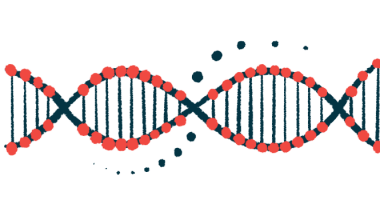Study Links Abnormal Gene Expression to Thicker Skin in SSc Patients

When gene expression — the process in which a gene gets turned ‘on’ in a cell to make proteins — is dysregulated or does not function the way it should normally, the affected skin of patients with systemic sclerosis (SSc) tends to be abnormally thicker, a study has found.
Researchers also observed that the gene expression tended to return to normal over time in patients with a subtype of the disease called early diffuse SSc.
“These observations are relevant for understanding SSc pathogenesis [disease processes] and could inform treatment strategies and clinical trial design,” the researchers wrote.
The study, “Large-scale analysis of longitudinal skin gene expression in systemic sclerosis reveals relationships of immune cell and fibroblast activity with skin thickness and a trend towards normalisation over time,” was published in the Annals of the Rheumatic Diseases.
Scleroderma, also known as SSc, occurs when certain cells called fibroblasts make too much collagen and other proteins. Collagen is normally used by the body to build connective tissue and repair wounds. Too much collagen, however, causes hardening and excessive scarring in the skin, making it thicker. Other organs in the body may be affected too.
Other cells — the immune cells — are activated early in the course of the disease and contribute to excessive scarring by making antibodies that mistakenly attack healthy tissues and releasing proteins that trigger immune responses.
To understand whether the gene expression of fibroblasts and immune cells may be used to find how the disease progresses, a team of researchers in the U.S. looked at all the genes that were ‘on’ in the skin of patients with SSc versus healthy controls.
In their study, the researchers looked at RNA — a molecule that contains information that has been copied from a gene and is needed to make a protein — and protein made from the RNA. Therefore, the researchers took two samples of skin — one for RNA and the other for protein analysis — measuring three millimeters in diameter from the forearm of 113 patients and 44 controls. In total, the study included 339 skin samples.
The patients had a mean age of 48.9 years and a mean disease duration of 2.6 years. In 75 (66.4%) of the patients, the first samples were taken from clinically affected skin. Most had a second and a third skin sample taken about one and two years apart from the first ones. The controls had a mean age of 50.4 years.
There were differences in the expression of more than 2,100 genes between patients and controls. The most differentially expressed genes (when the difference or change is considered significant) were involved in tissue scarring, and the adhesion and passage of immune cells through blood vessels to sites of injury in tissue. When the researchers focused on the group of patients who had clinically affected skin in the forearm, they found that the number of differentially expressed genes increased to more than 4,300.
Next, the scientists looked at gene expression signatures, or combinations of genes whose differential expression is linked to particular types of cells. They found that 67% of patients had a gene expression signature linked to fibroblasts and that slightly more than half had a signature linked to macrophages. Macrophages are immune cells that stimulate the action of other immune cells and are involved in eliminating bacteria and other harmful organisms.
Fibroblast and immune cell signatures were higher in patients with affected skin than in those with unaffected skin. Moreover, they correlated positively with the modified Rodnan Skin Score — a measure of skin thickness in patients with SSc. In other words, the more dysregulated the gene expression, the thicker the skin. On the contrary, they correlated inversely with disease duration in patients with diffuse SSc, meaning they were more evident in those with early disease.
To understand whether the gene expression signatures changed over time, the researchers compared the skin samples taken from patients at different time points. They found that in patients with early diffuse SSc, fibroblast and immune cell signatures declined over time, and that overall gene expression tended to return to a normal status.
In another experiment, the researchers looked at the skin samples under a microscope to watch for changes in markers of immune cells. They confirmed that most patients with early diffuse SSc who had initial high numbers of immune cells — namely T-cells and macrophages — in skin tissue saw these numbers decrease over time. This finding was consistent with the results of gene expression analysis.
“The large sample size, coupled to close clinical follow-up, allowed for retesting of hypotheses regarding relationships of skin gene expression to clinical disease features,” the researchers wrote. “We found a greater extent of dysregulated skin gene expression in patients with affected skin at the biopsy site compared with those with unaffected skin, and positive associations of immune cell and fibroblast signatures with skin thickness scores.”








